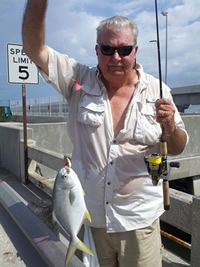The Tampa Bay Region began to dry out somewhat from the prior week, but afternoon thunderstorms still dumped some water into the estuary. The question on the mind of many folks visiting the Sunshine Skyway Fishing Piers becomes how do the rains impact the bites? Anglers willing to adapt can almost always find some fish at the piers. Fish species that cope well with lower salinity & water clarity are often the best targets during heavy rain periods. Some species that come to mind include mangrove snapper, tarpon, pompano, jacks, trout, snook, goliath grouper and sharks. Heavy tidal flows that are very common in the summer months can act to both clear water and replace salinity in a very short time. This past week saw bites from both fish preferring higher salinity & lower salinity.
Spanish mackerel remained on a solid bite for those wanting to target these pelagic fish, and although artificial lures remain good, natural baits are really beginning to shine. Gag grouper activity remained high, and some keepers have already been taken this young season, but shorter fish have been the dominant catch up to this point. Those wanting a monster grouper will find a great goliath grouper bite right now at both fish piers. Mangrove snapper have been excellent and limits are now quite common for anglers putting in the time. Bluefish & blue runners were attacking baitfish schools in the shallows & delighting anglers tossing artificial lures. Tarpon action is good, especially in the shadow line of the pier lights after sundown. Sharks are plentiful in all sizes & species for those seeking a toothy critter. Finally, look for a strong blue crab flush as we approach the New Moon in the middle of next week & crabs might be joined by jumbo shrimp & nice squid.
Spanish mackerel action was good as late morning high tides bled into late afternoon low tides, leading to many anglers catching fish right in the middle of the afternoon. Some very nice fish were mixed with fish just over the legal length, making bag limits of various sizes the norm. Silver Gotcha Lures with a red head and silver spoons fished behind a trolling weight were the ticket for many anglers. Live or freshly cut strip baits were the choice of anglers preferring a natural approach. Visitors willing to have various group members fish both artificial & natural baits and then switch to the hottest bait at that time performed very well. Your author watched a group outside the South Bait Shop work this to perfection Friday afternoon, and the result was a rapidly filling cooler of Spanish mackerel. Fish will usually tell you what they want at any given time – if you simply give them the opportunity.
Mangrove snapper are very adapted to dealing with rapid influxes of freshwater and changes in water clarity. This trait is most likely related to the way that these fish spend their juvenile years growing up in mangrove roots and other cover that lines tidal creeks & rivers along Florida’s Gulf Coast. If water clarity or salinity changes caused by summer storms seems to hurt mackerel action, then make the switch to snapper. If you have the most basic terminal tackle consisting of egg sinkers in the 1.5 oz. range, medium barrel swivels, 30 lb. monofilament leader material, and hooks in the 1/0 to 2/0 range, you are in the game for these fine tasting snapper at the piers right up until the first serious cold spells of the fall. Baits can range from cut sardines, herring, mullet, pinfish, or ladyfish all the way to live shrimp or live juvenile pinfish. Target the artificial reefs, bridge pilings, or even fish underneath the piers themselves with the tide, as these fish will be plentiful for many months.
Anglers have been taking both bluefish & blue runners by working artificial lures around surfacing baitfish schools. The blue runners seems to be attracted to the smaller members of the baitfish schools, and the bluefish to the larger ones. The two fish do look somewhat alike, but they are actually not even members of the same Family of Fishes. The bluefish has its own fish family designation, while the blue runner is a member of the Jack Family of Fishes. Both fish are strong fighters, actively take artificial baits, and have a wide range of either bait or culinary uses. Bluefish are generally much larger & broader, but Tampa Bay bluefish are nowhere near as large as the species grows in the northeastern portion of the U.S. One sure telltale sign is that the bluefish has smooth flesh right to the tail, whereas the blue runner has a sharp & bony structure leading to the tail. Both fish can be prepared using a wide variety of fish cookery methods and both benefit from bleeding before placing on ice.
- The Skyway, Paul Bristow - August 24, 2018
- The Skyway, Paul Bristow - August 17, 2018
- The Skyway, Paul Bristow - August 10, 2018











